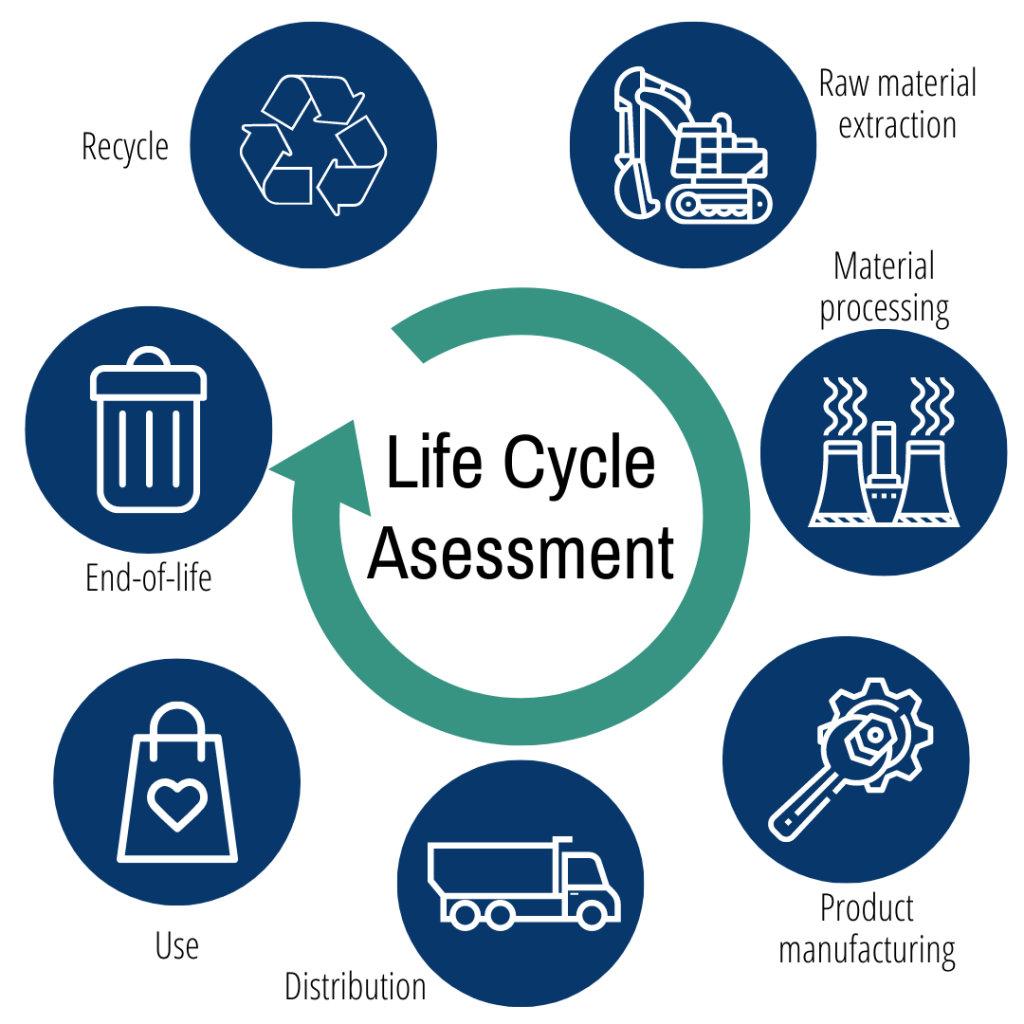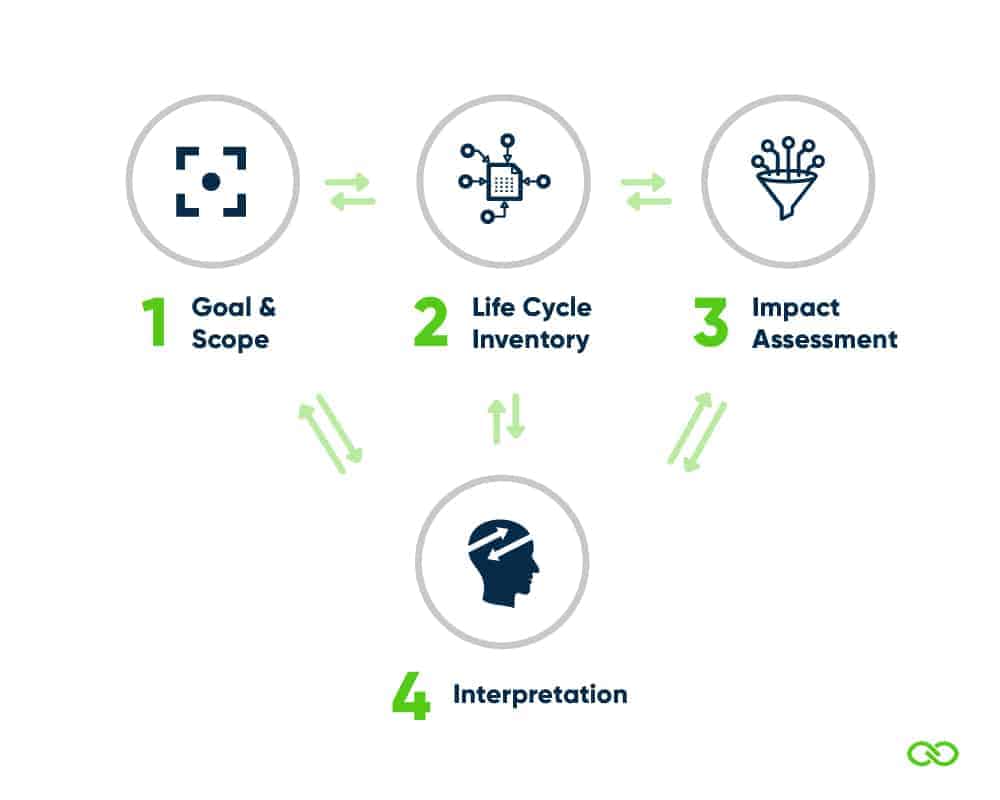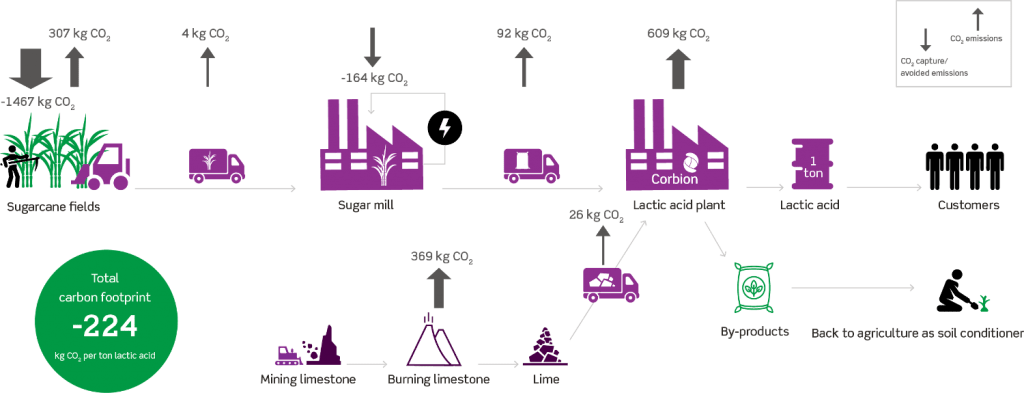62% of respondents in a global study want companies to behave in a more sustainable and eco-friendly way. And businesses that want to stay ahead of the curve will need to prove that they can walk-the-talk. This is where Life Cycle Assessment (LCA) comes in. It’s a must-have for businesses looking to make products more sustainable for a rapid growing environmentally-conscious market. And industries from banking and investment, to construction and fashion, are fast capitalising on its benefits.
What is a Life Cycle Assessment?
Simply put, LCA is a tool that measures a product’s environmental impacts during its life.
Products tend to cause environmental impacts from material extraction to waste disposal, also known as “cradle-to-grave”. LCA is a systematic approach to quantifying these impacts. It allows businesses to gain the full picture of a product’s sustainability score. It provides a framework to inform strategic decisions in the product development process.
LCAs are often data-intensive and need massive analytical resources. But they can produce significant insights into a product’s environmental, social and economic performance. These allow decision-makers to make impactful changes for their product to be sustainable in a holistic way.
How LCA started
LCAs came about in the 1960s, led by the rise in public awareness about environmental issues. These such as pollution, waste management, and resource depletion. This prompted many companies to seek to reduce their energy and resource use.
In 1969, Coca Cola became the first company to carry out an internal investigation into the manufacturing process of their containers. They wanted to determine their resource consumption, fuel consumption and environmental impact. This was the first step in developing a modern understanding of LCA. This methodology is Resource and Environmental Profile Analysis (REPA).
The Society of Environmental Toxicology and Chemistry (SETAC) and SETAC-Europe developed a “Code of Practice” by 1993, following a few similar studies. The work done by these scientific societies would later develop into the basis for the first set of environmental management standards.

LCA standards today
Today, the ISO 14040:2006 standards are the accepted global standards for conducting an LCA. They take into account the many different aspects of environmental and human health. There are also life cycle assessments that calculate social sustainability and economic sustainability.
Social sustainability measures the impact of a product or service on social wellbeing. This includes fair wages, equal employment, and others.
Economic sustainability looks at the overall costs of products or services (also known as Life Cycle Costing) throughout their lifetime. This helps make them economically viable in the long term. It advocates for efficiency and resiliency by accounting for various social and ecological interactions.
For instance, infrastructure projects that account for long term social needs in the face of increased extreme weather events will have a higher built-in resiliency. And hence, a longer life span, compared to a project that does not account for these factors. The initial development cost of such projects may be significantly higher. But when calculated over the span of its extended lifetime, they could prove to be more economically viable.
The four phases of Life Cycle Assessment
LCAs typically run in four phases. These work together to provide a clear picture of environmental impacts.

Phase 1: LCA goal & scope definition.
Phase one involves defining the goal and scope of your assessment. Its purpose is to ensure consistent performance of LCAs. This includes defining exactly what needs analysing, and how deep the analysis should go. A clearly defined goal and scope with system boundaries is a significant step in LCA modelling.
Phase 2: Inventory analysis of extractions and emissions.
The inventory analysis shows the environmental inputs and outputs of a product or service throughout its lifetime. Environmental inputs are raw materials taken from the environment, such as resources and energy. Environmental outputs, in contrast, represent anything that leaves the environment such as gases and waste. Together, they provide a full picture.
Phase 3: Life cycle impact assessment (LCIA).
This phase is significant to companies wanting to make strategic sustainability-based decisions. This phase identifies the impact values obtained from the analyses. And then categorises them based on the impact categories in use. Depending on the goal defined in Phase 1, the user can get a single sustainability score for a product. Or gain more detailed sustainability metrics.
Phase 4: Interpretation.
This is the final phase of the LCA. It is where the user draws conclusions from the analysis in previous steps. And presents the results to stakeholders in the business. The ISO14044 standards contain several checks to verify that the analysis included all appropriate and adequate data, according to the correct procedures.
An example of Life Cycle Assessment
Let’s take an example of life cycle assessment in action. Consider the case of Lactic Acid – an important chemical derived from sugarcane and used widely in products like food, cosmetics, and pharmaceuticals. The assessment tool gives a complete picture of its environmental impact as it travels from the sugarcane field to the consumer.

The illustration above factors in all components associated with the production of lactic acid into its life cycle. This includes the manufacture of its input materials – sugar and lime. The generation of its output materials – lactic acid and any by-products in the process. This includes the transportation between each stage.
It’s important to assess each stage of the life cycle for its environmental impact. In this example, they measure the volume of carbon emitted or absorbed in the process.
There are stages detrimental to the environment, like the burning of limestone to produce lime, that release carbon dioxide (CO2) into the atmosphere.
And there are stages helpful to the environment, like the cultivation of sugarcane fields, that absorb CO2.
But it is the cumulative impact across its entire value chain that determines lactic acid‘s net sustainability score.
The analysis conducted above is necessary because it gives a more complete picture of the product’s total CO2 interaction with the environment.
“Corporate social responsibility is a hard-edged business decision. Not because it is a nice thing to do or because people are forcing us to do it… because it is good for our business”
Niall Fitzerald, former CEO, Unilever.
Why Life Cycle Assessment is important for your business
LCA is a flexible tool that can be used for impact assessment in many different industries. Here are some of the benefits that adopting LCA can do for your business:
Regulatory compliance: LCA is ISO-compliant and accepted as a sound method of verifying environmental impacts and support claims. This is often important for businesses looking to participate in public sector projects.
Benchmarking: It allows environmental benchmarks for each stage of the product’s life cycle. This helps companies to track improvements. For supply chain managers, it provides a basis for evaluating suppliers on a more holistic level, beyond just price.
Corporate social responsibility: It allows a company to demonstrate transparency and corporate credibility to stakeholders and customers. Investors are increasingly taking ESG (Environmental, Social, Governance) indicators into consideration when assessing the long-term viability of a business.
Research and development: LCA informs new product development, when environmental footprint is an important factor for success in the market. It also helps in identifying opportunities for energy or water optimisation, thereby saving costs.
Competitive advantage: Companies use LCA data to support their Environmental Product Declarations (EPD) about their products. This new wave of eco-labelling gives businesses a competitive edge in marketing to a growing consumer base concerned with the environmental impacts of the products they use.
“People are going to want, and be able, to find out about the citizenship of a brand, whether it is doing the right things socially, economically and environmentally.”
Mike Clasper President of Business Development, Proctor and Gamble (Europe)
How you can begin with LCA
So, life cycle assessment is not just a buzzword in sustainability circles. It is a way of gaining intelligence into how your business is operating on an environmental level. And using that intelligence to improve the sustainability of your business in the long run.
After all, the less dependent you are on natural resources, the better your business will be at weathering the environmental risks and rising costs associated with climate change. And the greener you are, the more your brand will endear itself to an increasingly consumption conscious audience.
Unsure where to start? Our blog post introduces a list of reputable organisations that offer sustainability and environmental certification programs across a number of industries. Get started on yours today.
THRIVABILITY
We at THRIVE are not only aiming to educate people about sustainability but also provide a platform where entities can assess their own sustainability performance at various scales using different internationally recognised benchmarks and standards. Please make sure to visit our blogs to know more!























